Guanghui Zhu
SA-GNAS: Seed Architecture Expansion for Efficient Large-scale Graph Neural Architecture Search
Dec 03, 2024


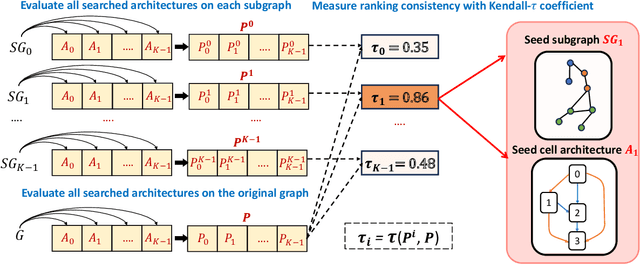
Abstract:GNAS (Graph Neural Architecture Search) has demonstrated great effectiveness in automatically designing the optimal graph neural architectures for multiple downstream tasks, such as node classification and link prediction. However, most existing GNAS methods cannot efficiently handle large-scale graphs containing more than million-scale nodes and edges due to the expensive computational and memory overhead. To scale GNAS on large graphs while achieving better performance, we propose SA-GNAS, a novel framework based on seed architecture expansion for efficient large-scale GNAS. Similar to the cell expansion in biotechnology, we first construct a seed architecture and then expand the seed architecture iteratively. Specifically, we first propose a performance ranking consistency-based seed architecture selection method, which selects the architecture searched on the subgraph that best matches the original large-scale graph. Then, we propose an entropy minimization-based seed architecture expansion method to further improve the performance of the seed architecture. Extensive experimental results on five large-scale graphs demonstrate that the proposed SA-GNAS outperforms human-designed state-of-the-art GNN architectures and existing graph NAS methods. Moreover, SA-GNAS can significantly reduce the search time, showing better search efficiency. For the largest graph with billion edges, SA-GNAS can achieve 2.8 times speedup compared to the SOTA large-scale GNAS method GAUSS. Additionally, since SA-GNAS is inherently parallelized, the search efficiency can be further improved with more GPUs. SA-GNAS is available at https://github.com/PasaLab/SAGNAS.
Simple and Efficient Partial Graph Adversarial Attack: A New Perspective
Aug 15, 2023Abstract:As the study of graph neural networks becomes more intensive and comprehensive, their robustness and security have received great research interest. The existing global attack methods treat all nodes in the graph as their attack targets. Although existing methods have achieved excellent results, there is still considerable space for improvement. The key problem is that the current approaches rigidly follow the definition of global attacks. They ignore an important issue, i.e., different nodes have different robustness and are not equally resilient to attacks. From a global attacker's view, we should arrange the attack budget wisely, rather than wasting them on highly robust nodes. To this end, we propose a totally new method named partial graph attack (PGA), which selects the vulnerable nodes as attack targets. First, to select the vulnerable items, we propose a hierarchical target selection policy, which allows attackers to only focus on easy-to-attack nodes. Then, we propose a cost-effective anchor-picking policy to pick the most promising anchors for adding or removing edges, and a more aggressive iterative greedy-based attack method to perform more efficient attacks. Extensive experimental results demonstrate that PGA can achieve significant improvements in both attack effect and attack efficiency compared to other existing graph global attack methods.
HAGNN: Hybrid Aggregation for Heterogeneous Graph Neural Networks
Jul 04, 2023Abstract:Heterogeneous graph neural networks (GNNs) have been successful in handling heterogeneous graphs. In existing heterogeneous GNNs, meta-path plays an essential role. However, recent work pointed out that simple homogeneous graph model without meta-path can also achieve comparable results, which calls into question the necessity of meta-path. In this paper, we first present the intrinsic difference about meta-path-based and meta-path-free models, i.e., how to select neighbors for node aggregation. Then, we propose a novel framework to utilize the rich type semantic information in heterogeneous graphs comprehensively, namely HAGNN (Hybrid Aggregation for Heterogeneous GNNs). The core of HAGNN is to leverage the meta-path neighbors and the directly connected neighbors simultaneously for node aggregations. HAGNN divides the overall aggregation process into two phases: meta-path-based intra-type aggregation and meta-path-free inter-type aggregation. During the intra-type aggregation phase, we propose a new data structure called fused meta-path graph and perform structural semantic aware aggregation on it. Finally, we combine the embeddings generated by each phase. Compared with existing heterogeneous GNN models, HAGNN can take full advantage of the heterogeneity in heterogeneous graphs. Extensive experimental results on node classification, node clustering, and link prediction tasks show that HAGNN outperforms the existing modes, demonstrating the effectiveness of HAGNN.
AutoAC: Towards Automated Attribute Completion for Heterogeneous Graph Neural Network
Jan 08, 2023



Abstract:Many real-world data can be modeled as heterogeneous graphs that contain multiple types of nodes and edges. Meanwhile, due to excellent performance, heterogeneous graph neural networks (GNNs) have received more and more attention. However, the existing work mainly focuses on the design of novel GNN models, while ignoring another important issue that also has a large impact on the model performance, namely the missing attributes of some node types. The handcrafted attribute completion requires huge expert experience and domain knowledge. Also, considering the differences in semantic characteristics between nodes, the attribute completion should be fine-grained, i.e., the attribute completion operation should be node-specific. Moreover, to improve the performance of the downstream graph learning task, attribute completion and the training of the heterogeneous GNN should be jointly optimized rather than viewed as two separate processes. To address the above challenges, we propose a differentiable attribute completion framework called AutoAC for automated completion operation search in heterogeneous GNNs. We first propose an expressive completion operation search space, including topology-dependent and topology-independent completion operations. Then, we propose a continuous relaxation schema and further propose a differentiable completion algorithm where the completion operation search is formulated as a bi-level joint optimization problem. To improve the search efficiency, we leverage two optimization techniques: discrete constraints and auxiliary unsupervised graph node clustering. Extensive experimental results on real-world datasets reveal that AutoAC outperforms the SOTA handcrafted heterogeneous GNNs and the existing attribute completion method
A2: Efficient Automated Attacker for Boosting Adversarial Training
Oct 07, 2022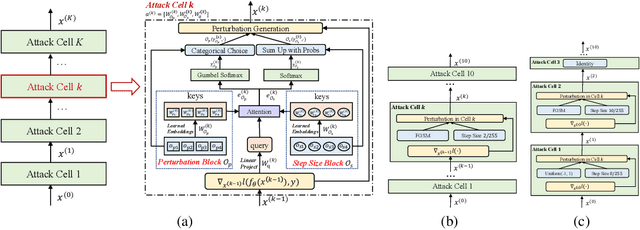

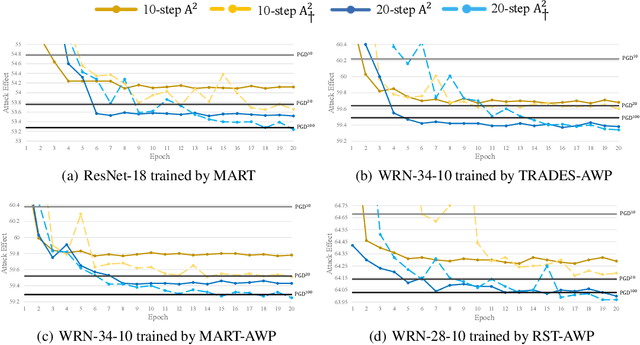
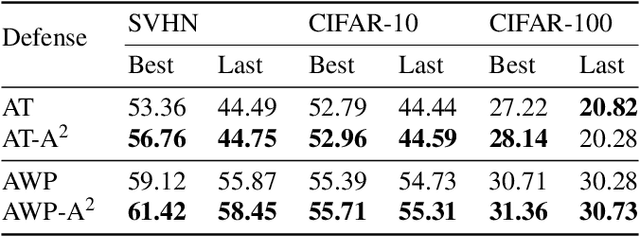
Abstract:Based on the significant improvement of model robustness by AT (Adversarial Training), various variants have been proposed to further boost the performance. Well-recognized methods have focused on different components of AT (e.g., designing loss functions and leveraging additional unlabeled data). It is generally accepted that stronger perturbations yield more robust models. However, how to generate stronger perturbations efficiently is still missed. In this paper, we propose an efficient automated attacker called A2 to boost AT by generating the optimal perturbations on-the-fly during training. A2 is a parameterized automated attacker to search in the attacker space for the best attacker against the defense model and examples. Extensive experiments across different datasets demonstrate that A2 generates stronger perturbations with low extra cost and reliably improves the robustness of various AT methods against different attacks.
Knowledge-enhanced Black-box Attacks for Recommendations
Jul 21, 2022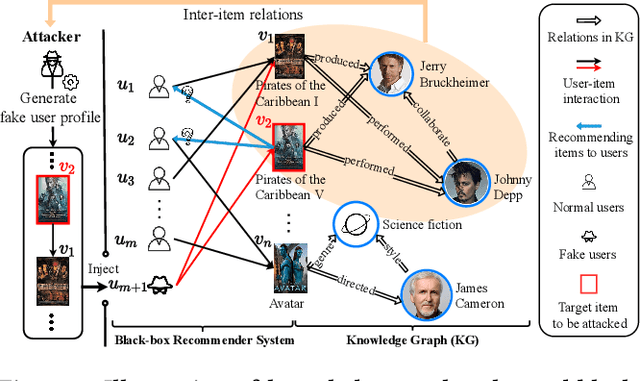
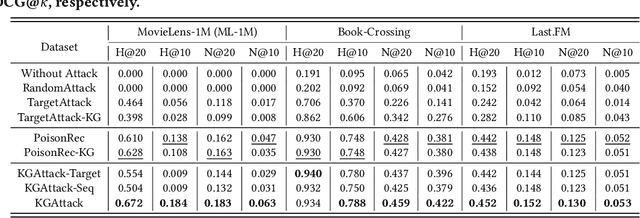
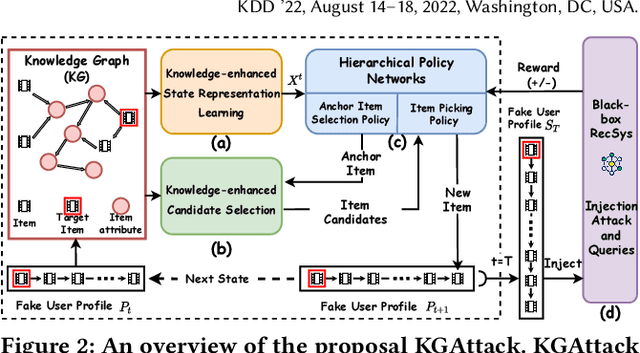
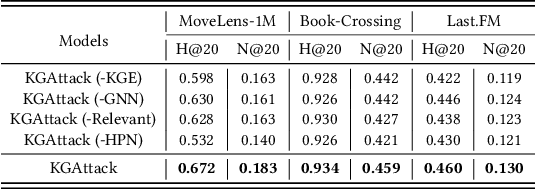
Abstract:Recent studies have shown that deep neural networks-based recommender systems are vulnerable to adversarial attacks, where attackers can inject carefully crafted fake user profiles (i.e., a set of items that fake users have interacted with) into a target recommender system to achieve malicious purposes, such as promote or demote a set of target items. Due to the security and privacy concerns, it is more practical to perform adversarial attacks under the black-box setting, where the architecture/parameters and training data of target systems cannot be easily accessed by attackers. However, generating high-quality fake user profiles under black-box setting is rather challenging with limited resources to target systems. To address this challenge, in this work, we introduce a novel strategy by leveraging items' attribute information (i.e., items' knowledge graph), which can be publicly accessible and provide rich auxiliary knowledge to enhance the generation of fake user profiles. More specifically, we propose a knowledge graph-enhanced black-box attacking framework (KGAttack) to effectively learn attacking policies through deep reinforcement learning techniques, in which knowledge graph is seamlessly integrated into hierarchical policy networks to generate fake user profiles for performing adversarial black-box attacks. Comprehensive experiments on various real-world datasets demonstrate the effectiveness of the proposed attacking framework under the black-box setting.
Transition Relation Aware Self-Attention for Session-based Recommendation
Mar 12, 2022


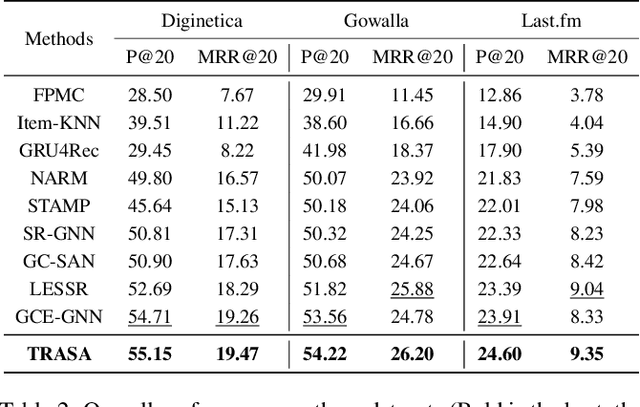
Abstract:Session-based recommendation is a challenging problem in the real-world scenes, e.g., ecommerce, short video platforms, and music platforms, which aims to predict the next click action based on the anonymous session. Recently, graph neural networks (GNNs) have emerged as the state-of-the-art methods for session-based recommendation. However, we find that there exist two limitations in these methods. One is the item transition relations are not fully exploited since the relations are not explicitly modeled. Another is the long-range dependencies between items can not be captured effectively due to the limitation of GNNs. To solve the above problems, we propose a novel approach for session-based recommendation, called Transition Relation Aware Self-Attention (TRASA). Specifically, TRASA first converts the session to a graph and then encodes the shortest path between items through the gated recurrent unit as their transition relation. Then, to capture the long-range dependencies, TRASA utilizes the self-attention mechanism to build the direct connection between any two items without going through intermediate ones. Also, the transition relations are incorporated explicitly when computing the attention scores. Extensive experiments on three real-word datasets demonstrate that TRASA outperforms the existing state-of-the-art methods consistently.
DIFER: Differentiable Automated Feature Engineering
Oct 17, 2020



Abstract:Feature engineering, a crucial step of machine learning, aims to extract useful features from raw data to improve data quality. In recent years, great efforts have been devoted to Automated Feature Engineering (AutoFE) to replace expensive human labor. However, existing methods are computationally demanding due to treating AutoFE as a coarse-grained black-box optimization problem over a discrete space. In this work, we propose an efficient gradient-based method called DIFER to perform differentiable automated feature engineering in a continuous vector space. DIFER selects potential features based on evolutionary algorithm and leverages an encoder-predictor-decoder controller to optimize existing features. We map features into the continuous vector space via the encoder, optimize the embedding along the gradient direction induced by the predicted score, and recover better features from the optimized embedding by the decoder. Extensive experiments on classification and regression datasets demonstrate that DIFER can significantly improve the performance of various machine learning algorithms and outperform current state-of-the-art AutoFE methods in terms of both efficiency and performance.
Semi-supervised Embedding Learning for High-dimensional Bayesian Optimization
May 29, 2020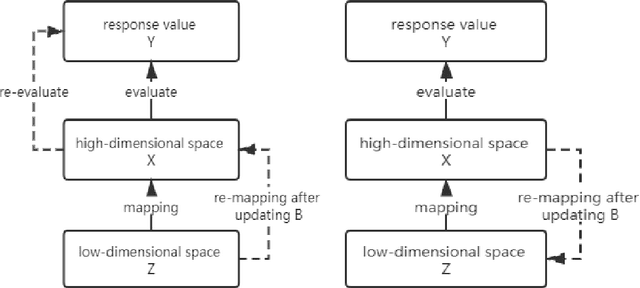
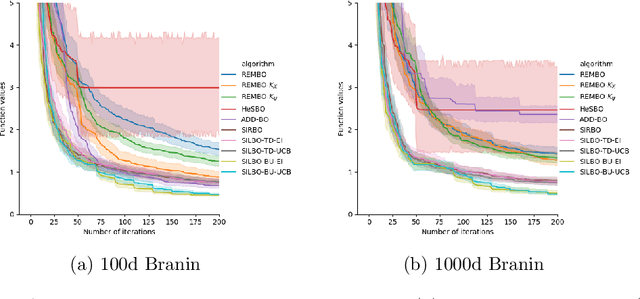
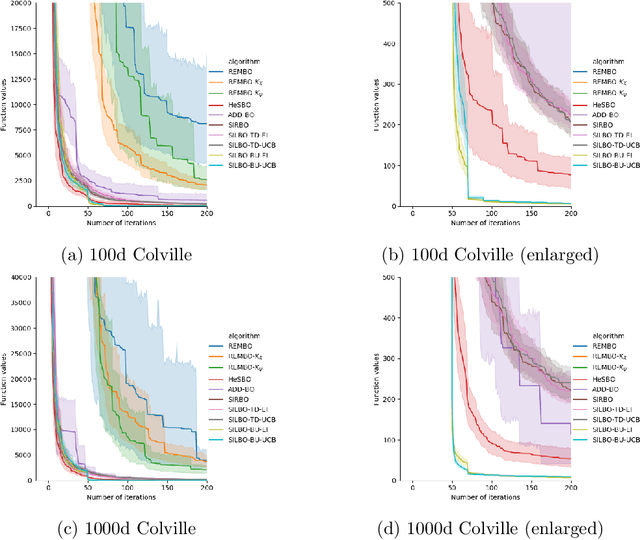
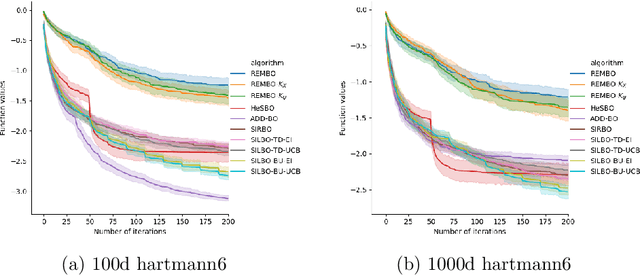
Abstract:Bayesian optimization is a broadly applied methodology to optimize the expensive black-box function. Despite its success, it still faces the challenge from the high-dimensional search space. To alleviate this problem, we propose a novel Bayesian optimization framework (termed SILBO), which finds a low-dimensional space to perform Bayesian optimization iteratively through semi-supervised dimension reduction. SILBO incorporates both labeled points and unlabeled points acquired from the acquisition function to guide the embedding space learning. To accelerate the learning procedure, we present a randomized method for generating the projection matrix. Furthermore, to map from the low-dimensional space to the high-dimensional original space, we propose two mapping strategies: $\text{SILBO}_{FZ}$ and $\text{SILBO}_{FX}$ according to the evaluation overhead of the objective function. Experimental results on both synthetic function and hyperparameter optimization tasks demonstrate that SILBO outperforms the existing state-of-the-art high-dimensional Bayesian optimization methods.
 Add to Chrome
Add to Chrome Add to Firefox
Add to Firefox Add to Edge
Add to Edge